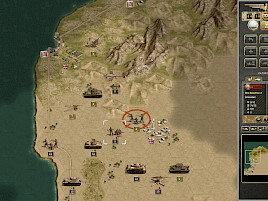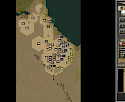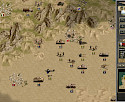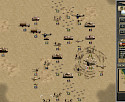Panzer Corps: Afrika Korps Developer Diary
Panzer Corps brings war to the desert! The player takes on the role of Rommel in charge of the famed Deutsches Afrikakorps, leading its troops to become the stuff of legends.
The game introduces quite a number of novelties in all segments due to the change in the theatre of operations involved. There will be new terrain types and tiles, new units were added and there's a new desert camouflage for the existing ones. The new art for the main menu is simply awesome, there's new music, an intro trailer and the library has been extended with new illustrations and text entries regarding WW2 airplanes.
New unit-related features will have some equipment being specifically included or excluded depending on whether they'll be operating on the European or African theatres, but the more interesting bit has to do with the changes in the transportation system, where the use of gliders has been instituted.
The player will thusly have the opportunity to protect his Me 323 Gigants as it delivers much needed supplies to Tunisia, or to deploy his Gebirgsjäger from a DFS 230 in the airborne invasion of Malta.
Among other novelties, some of the new units include the British Long Range Desert Groups and the Italian Saharan companies for encounters deep into the desert, Tobruk perimeter fortifications can be softened with flamethrower tanks, the rearguard organized with fast moving motorcycle infantry and, for added historical flavour, the player can even pull his mighty eighty-eight with a Sd.Kfz. 7 half-track.
The already powerful Panzer Corps Editor is fast becoming a real killer app. I'm sure modders will appreciate it and will enjoy using what it brings to the table. Beyond an assortment of smaller things, there are some really cool ones, like the ability to add Heroes to units, but its real power lies in the redesigned way of scripting and the considerably expanded list of AI behaviours.
The guiding principle behind all this was to create a more dynamic battlefield experience. The game now supports adding or removing victory objectives from the map during the course of a scenario, events can be linked in a chain, units randomly pre-deployed, and counterattacks can happen with a certain probability, so leading to an ever changing environment.
All this is supported with in-game messages and visual representation of the changed conditions on the map. The new AI scripting has also enabled the recreation of certain historical events like 8th Army's flanking attack around the Mareth Line, the British and Commonwealth withdrawal from the Gazala Line when Tobruk was in jeopardy, the chase across Cyrenaica after Allied successes during Operation Crusader, and much more. In the vast open spaces of the Western Desert flanking is something to watch out for!
One of the main novelties about the Campaign is the support for multi-factional core units. So, alongside German units, the player will control Italian ones as part of his core force.
The Campaign consists of 24 scenarios and supports playing the historical campaign from Libya in 1941 to Tunisia in 1943, as well as fictional scenarios, ending with British India in 1944.
Designing the Campaign was not easy in terms of the choices we faced. We wanted a longer campaign with less branching so that the overall playing experience along a certain campaign path was better and more extensive.
We also wanted to maintain a good ratio between historical and fictional scenarios. All major operations from 1941-1943 are covered, and we provide the opportunity to change history, to conquer Middle East, and beyond.
The historical see-saw nature of the fights in the desert did not help us at all, but in the end we've come to the conclusion that the best option was to allow for change in history to happen in the year 1942, during the Alam el Halfa battle, and scenarios prior to that are linked historical ones connected with logical storytelling.
All the major historical events of the time are covered, from the offensive in Cyrenaica, the probing of Tobruk defences, Brevity, Battleaxe, all the way to the chaotic fights during crusader and the fighting withdrawal that turned into the Second offensive after it.
In the Gazala Line, for instance, there's an epic feeling reinforced by historical order of battle, unit placement and unit naming, aspects which it shares with many other scenarios.
Among those, of course, there's also one "what if" scenario, so after capturing Tobruk in 1942 the player is invited to choose for or against the invasion of Malta.
After conquering the Middle East further progress in the direction of the Caucasus is only to be expected, but we wanted to add something more and at the same time focus our conflict on the British.
This is where storytelling was made to take a leap, with a hypothetical British plan for a counterattack from the East African colonies with the aim to recapture the Suez Canal. After this, the story will pull us deeper into conflict and lead us On the Road to India.
British India is the final prize and grand finale in this hypothetical campaign of conquest. For those wishing to explore the last stand in Tunisia, not changing history, the Alam el Halfa battle is the way to go. Even if Monty's 8th Army during battle of El Alamein is held it will not change much because a new threat is on the horizon as Operation Torch is on its way.
In scenario design great care was taken to include a variety of settings, changed conditions and some surprises. The player can start his mission with a limited reconnaissance force only to have things turn into a full blown offensive, then he can ignore Allied forces at Sidi Rezegh and dash to the Libyan-Egyptian border to destroy British supply dumps. Fighting withdrawals will be executed and turned into decisive blows when reinforcements arrive.
The player will fight against SAS raids in the rear, recover damaged enemy tanks from abandoned battlefields, perform rescue missions on remote locations, protect pipeline stations from destruction, cut Land Lease convoys into pieces, and much more.
The main focus of scenario design was to create a truly dynamic battlefield that will ensure a better playing experience. Objectives can be added or discarded during the course of a mission, events randomized so that a certain counterattack could come from any of several possible directions, making each scenario play out differently every time. The new AI scripting, for example, has brought greater flexibility in moving AI units on the field which has opened up new possibilities in terms of raids and unexpected flank attacks, and Exit Zones enable units to move to safety, out of the map, which can lead to a race to destroy them before they leave the area.
Some of the hit and run special missions can really keep adrenaline levels high and, between all that, there are also scenarios intended to change the pace during the campaign, relying on unusual tactics to be used, like fighting in mountainous terrain at Kasserine, or assaulting heavily fortified lines without air support.
I hope you'll enjoy playing the game as much as we enjoyed creating it and don't forget: watch your flank, Afrika Korps is coming!
Article written by: Kresimir Cuturic, Panzer Corps Development Team





